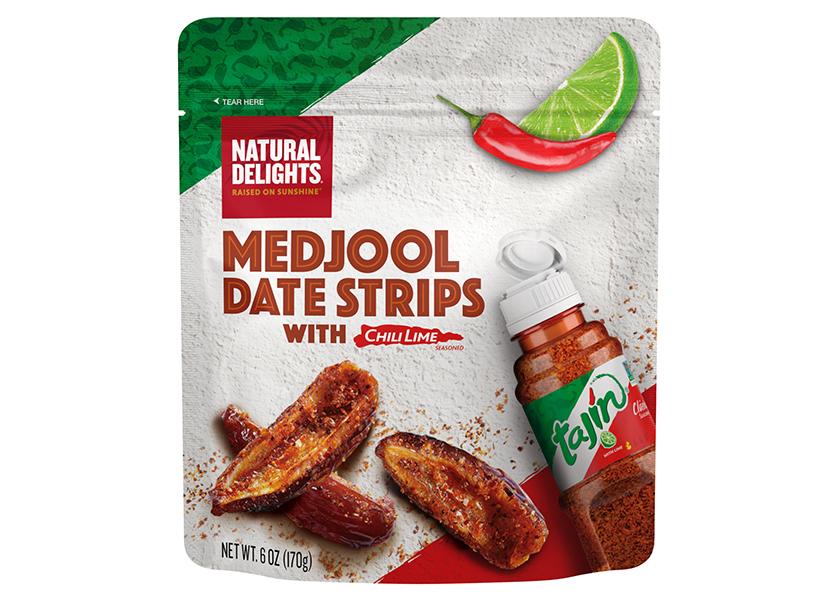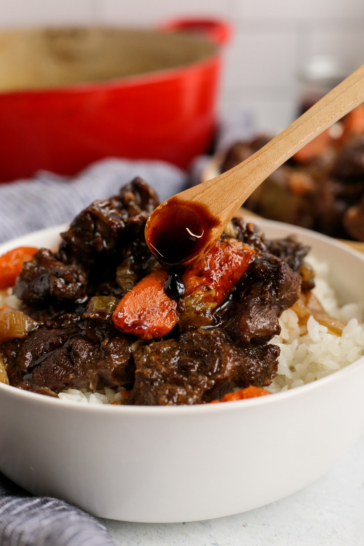Medjool dates are known as the “king of dates” for their large size and delicious flavor. But where do dates come from? And why are dates so expensive? Come with me for a harvest tour to get a behind-the-scenes glimpse into the date growing and harvesting process. You will have a whole new appreciation for these sweet little fruits!

Disclosure: I was invited to attend this harvest tour by Natural Delights, who covered my costs to attend. However, I was not paid to attend nor was I compensated to share this post. All opinions are my own and reflect my observations from the sponsored tour.
I was recently invited out to Yuma, Arizona with Natural Delights to be a part of medjool date harvest! This takes place every year in late summer, and I jumped at the opportunity to get a first-hand experience seeing the action up close and personal. Natural Delights medjool dates are grown and packed in Arizona, so they are a U.S. product.
You can watch my travel vlog and farm tour recap on my YouTube channel. Or just keep reading to learn everything you need to know about where dates come from!
What I’ll Cover In This Guide to Medjool Dates
But before I get into the details of date harvest, I want to share a little bit about why dates are such an interesting and important fruit.

Brief History of Dates
The date fruit has a long and storied history, playing a significant role for many cultures, religions, and cuisines since ancient times. Throughout their nearly 6000-years of cultivation, date palm trees (plant name phoenix dactylifera) have grown in what is now the Middle East and North Africa. Medjool dates were especially well-suited for growing in Morocco, but in the early 1900s they began struggle with disease just as dates were growing in popularity.
Modern medjool dates got their start in America when several offshoots were brought to the western United States in the 1940s. The climate was similar enough to make an effort to save the Moroccan medjool date trees. Half of them were planted in the Coachella Valley (California) and half of them were planted in the Bard Valley (overlapping parts of southern California and southwest Arizona). This is the area we toured on our sponsored trip with Natural Delights. Two of the original date palm trees survive to this day!
This region turned out to be an ideal new home for Medjool date palm trees. These trees only grow in a very specific climate and environment, requiring three important things:
- At least 100 days over 100 degrees F
- A dry, arid climate with little to no humidity
- Enough water to support the trees with minimal irrigation
The Bard Valley near Yuma, Arizona offers all of the above. This region is fed by the Colorado river, with a water table that sits high enough that the date palm trees can actually root down into it. And the low humidity means there’s less need for pesticides to control insects and other threats.
Rising Popularity in Modern Times
The timing of transplanting date palm trees coincided with the rise of the film industry in the early 20th century. Some silent films romanticized the seemingly foreign and exotic world of deserts, dancers, and dates. Think “Arabian Nights” with small towns who relied on agriculture to sustain their economy turned to tourism to highlight their unique ability to grow such a delectable fruit. They hosted fairs and other events to draw in anyone who had yet to discover the allure of dates.
This was an effective strategy, despite the obviously problematic misrepresentation of the people and cultures of the SWANA (Southwest Asia and North Africa) region. Within a few short decades dates were the darling of the culinary world as a natural sweetener. Many health-conscious people were eager to try date sugar and date syrup, from home cooks to professional bakers. The caramel-like taste added richness to sweet recipes and savory dishes alike.
Check out my list of favorite date recipes, including a few from fellow tour attendees: What to Make with Dates: Sweet and Savory Recipes.

In the early 2000s, there was an even greater focus on healthful eating. Medjool dates have become more popular than ever as people seek an alternative to sugar. As a non-diet dietitian, I must include the reminder that natural sugars, such as those from dates and other fruit, is still a type of simple carbohydrate (sugar). If you’re curious about where sugar comes from, check out my farm tour recap from a sugar cane farm in Louisiana.
In recent years, dates have become an important crop for world exports. There are different varieties of dates grown around the world. Other growing regions include Morocco, Palestine, Algeria, Saudi Arabia, and Jordan.
Dates are especially significant for Muslims, who include dates in their Ramadan traditions. Dates are commonly used to break the fast (iftar) and the energy and nutrients they provide are easily digested even on an empty stomach.
And different types of dates include deglet noor dates, ajwa dates, and sukkari dates, among many others. According to the Agricultural Marketing Resource Center, the United States exported 4.5 million pounds of fresh dates. Most of these went to Mexico, Canada, and Australia, although there is also increased demand for dates in Asian countries.
Growing Medjool Dates
Once established in the Bard Valley and Coachella Valley, the date palms began to thrive. While technology and other innovations have certainly helped with growing dates, some aspects have changed very little over thousands of years of cultivation. Many of the tasks are still done by hand or human labor.
I’ll share an overview of how medjool dates are grown. It’s incredibly labor intensive because you cannot propagate a date palm tree simply by planting one of the date pits. The pollen from a male tree must be applied to the canopy of a female tree to set fruit. But it’s made more difficult because you can’t tell whether a new shoot is male or female until it flowers in the spring. Most flowering trees take 3-5 years to enter production, and it can be a 7-year process total from shoot to harvest.
Once pollen is sprayed into the female trees and fruit is set, farm workers must thin out the strands of dates. Otherwise it becomes crowded and the tree will only yield small fruits. The fruit arms where the dates grow from must be tied to a large frond to support its weight.

By June, the dates start turning from green to yellow. Mesh bags are placed over the medjool date bunches to protect against birds and other pests. But with the low humidity, there’s no need to apply pesticides so the majority of dates are grown using organic growing methods.
While pests aren’t a huge concern, moisture is. August monsoons can bring rain that might result in mold issues or a sour flavor. But by this point, it’s just a waiting game until it’s time to start harvesting dates!
Harvesting Medjool Dates
The harvesting process begins in late summer. The harvest crews ascend into the treetops in specially-designed lifts with safety harnesses clipped to the railings. A medjool date palm tree can be more than 40 feet tall, growing at a rate of about one foot per year.
We had an opportunity to try harvesting dates to see how challenging it can be. You must position the mesh bags over the trays and shake the bags to release the ripe dates. The trays are color coded according to which farm they are harvesting from. Each tree can yield up to 200 pounds of fresh dates.

Harvest crews will repeat this entire process a few more times. This is is one major reason why medjool dates are so expensive. Not all the dates ripen at the same time, meaning they’ll go up and down in the same tree multiple times to ensure they harvest as many as possible. There is just no easy way to do this with automation like with other crops.
Quality Control, Food Safety, and Sustainability
Some sorting takes place in the field, removing any medjool dates that are unripe or too dried. We quickly spread the dates on our trays before tying up the mesh bags again and moving on to the next one.
Any medjool dates that are unripe or have defects like skin tears are discarded. As a food safety precaution, the U.S. Department of Agriculture (USDA) does not allow the collection of harvested date fruits that came in contact with the ground. The unripe dates are very firm and bright yellow. They almost look like little baby potatoes!
The date industry is striving to be more sustainable and find creative ways to use these culled or discarded dates. They may go into animal feed or a high sugar content slurry to apply to lettuce fields to combat the fusarium bacteria. There are also attempts to turn the pits into packaging to reduce plastic use.
The trays quickly stack up with harvested dates and are transported to the packing facilities within 24 hours. The farmworkers will work in this manner until the end of date season. Then they move on to harvest lettuce and leafy greens, then broccoli or cauliflower, then back to dates. Yuma is known as the “salad bowl” of North America and provides most of the country with lettuce and leafy greens through the winter when they can’t be grown in California.
Processing Medjool Dates
Once the medjool dates arrive at the processing facilities, they are sorted and graded according to their water content or moisture level. Ironically, the freshest, juiciest dates we ate in the field are not the best dates for packing. They’re simply too fragile and soft. An ideal date for packing has about 17-22% moisture and firm flesh. They can handle being jostled around on conveyor belts and packing lines.

We also got to try our hand at sorting dates. We sorted Grade 2 dates (which are ready to pack) from Grades 3, 4, and 5. Those dates either need more time to dry or will be processed into something other than whole dates. Sorting is not easy work by any means! The conveyor belts move quickly and it takes a lot of focus to keep up.
From here, the ready-to-pack dates are sent on while the rest are transferred into drying rooms. Pallets of trays filled with dates are zipped around the packing facility by forklifts. They’re stacked in giant warehouse rooms that replicate the same hot, dry environment at the top of a date palm tree. We were told these rooms can hold up to 50,000 pounds of dates each and they’re projecting a total harvest of 35 million pounds this year. The drying can also be done in a greenhouse setting that requires less energy input.

I found it so interesting that just steps beyond the processing facility was another bunch of date palm trees. There’s a huge advantage to only needing to transport the medjool dates a few miles, or less, from the field where they were recently harvested. And once they’re ready to pack, the process moves very quickly. Some jobs are still done by hand but there’s also a lot of automation and precision.
Packing Medjool Dates
The mejdool dates get a quick rinse, which removes about 98% of any remaining dust or debris, and then they’re sorted by size and weight. It’s amazing how fast these machines is able to do it accurately! Depending on which orders or retailers they’re packing for, the dates are then sorted into the proper categories and portioned out with a giant hopper. The dates are dispensed into a container, sealed, and labeled for traceability purposes.

Dates that don’t make the cut are destined for what the industry calls “a value-added product”. My favorite are these mini medjools. They’re smashed into a date paste then frozen and either mixed with other ingredients or rolled in coconut to create this really yummy snack. We got to taste one off the line and it tasted SO good! Other date products include truffles, dried dates for baking, and the brand new chili-lime date strips from Natural Delights.

How to Store Dates
This is probably one of the most frequently asked questions I get about medjool dates. And after attending this sponsored harvest tour, I can give a definitive answer!
The best way to store your medjool dates after getting them home from the grocery store is at room temperature. However, if you don’t plan to use them or eat them, medjool dates can also be stored in the fridge or freezer. They have a shelf life of up to one year from the date of purchase. If you store them in the freezer, they can last even longer.
If you notice a white, crystallized appearance, your dates are drying out. Simply soak in some warm water to soften them up before eating or cooking. Or wrap them loosely in a damp paper towel and microwave for a few seconds. Your dry dates should plump right back up!
Celebrating Delicious Dates
I hope this satisfies your curiosity if you ever wondered where medjool dates come from. It was such a treat to witness date harvest first-hand. A huge thank you to Natural Delights for inviting me to Arizona for this sponsored trip!

Next time you’re at the grocery store, you’ll have a much better understanding of what it took to get medjool dates to your table. And you’ll also know why dates are so expensive! At this point I question why they don’t cost more! I now realize how labor-intensive the date growing and harvest process truly is.
I’m very excited to keep experimenting in my kitchen. I’ll be sharing more recipes that highlight the sweet taste of these little fruits soon. I’m also working on a detailed post about the health benefits of dates.
Stay tuned, and as always, thanks for stopping by the Street Smart Nutrition blog. Cheers to more fearlessly nourishing meals!













